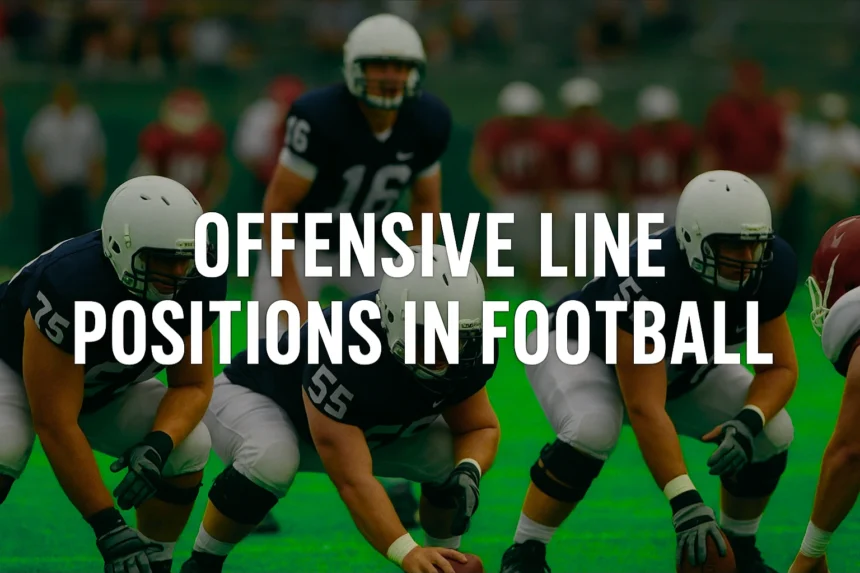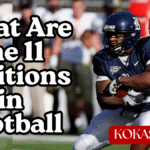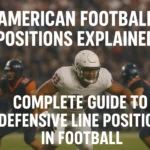The Offensive Line Positions in Football is the backbone of every football team. These five big players stand at the line of scrimmage and work together to make every play possible. Without good offensive line performance, the quarterback cannot throw passes, and the running back cannot run the ball. Every successful football team needs strong players in these positions in football.
When you watch a football game, you see 11 players on the field for each team. The offensive line has five offensive linemen who usually line up next to each other. These football players are typically the biggest and strongest people on the football field. They protect the quarterback and create holes for the running back to run through. The offensive line positions in football works as one unit to help their team move the ball forward.
Offensive Positions in Football Among All American Football Positions
What Are Offensive Line Positions in football and How They Work
The offensive line includes five specific jobs that work together perfectly. These american football positions are the center, left guard, right guard, left tackle, and right tackle. Each offensive lineman has special jobs to do on every offensive play.
The main job of all offensive line players is simple but crucial. On run plays, they must push the defensive line backward and create holes for the running back. On pass play situations, they must protect the quarterback from defensive player trying to tackle him. These positions in football require players who are big, strong, and very smart.
The offensive line consists of players who line up in a specific order. The center stands in the middle of the offensive line. Two offensive guards stand next to the offensive center. Two offensive tackles stand on the outside of the offensive line at the edges of the line. This setup helps the quarterback and running back succeed on every play.
Read Also: What Are the 11 Positions in Football: American Football Positions Explained
How Offensive Line Players Work Together
The offensive line must work as one team against the opposing team. Before each play starts, they communicate about what the defensive team is doing. The offensive center usually leads these talks because he can see the whole defense better than others. He tells the other players which defensive lineman they need to block defensive against.
Communication is very important for these positions and responsibilities. When the quarterback calls out signals, the offensive line players listen carefully. They need to know if the play will be a run or pass. This helps them get ready to do their specific job on that play against the first line of defense.
Five Essential Offensive Line Positions in Football: Positions Explained in Detail
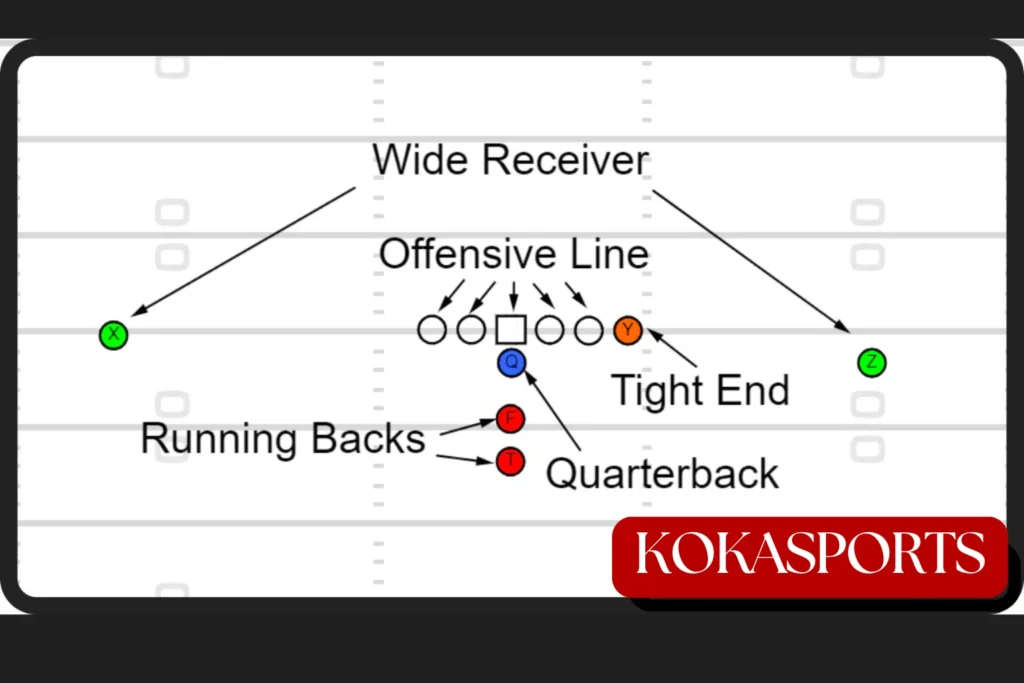
Center – The Leader Among Offensive Line Players
The center is like the quarterback of the offensive line. This player on the field has the most important job because he must snap the ball to start every play. The offensive center grabs the ball and throws it backward to the quarterback who stands behind the offensive line.
Key responsibilities of the center include:
- Snap the ball accurately to the quarterback
- Calling out protection plans to other offensive lineman players
- Blocking the nose tackle or defensive tackle in front of him
- Helping other players with double-team blocks
- Making sure everyone knows their blocking assignments
The center must be very smart because he needs to read what the defense is doing. He looks at how the linebacker and defensive lineman are lined up near the line of scrimmage. Then he tells his teammates what to expect. This helps the whole offensive team be ready for the play.
Centers face tough opponents like the nose tackle or middle linebacker who line up right in front of them. Even though centers might be smaller than other offensive line players, they use good technique and help from teammates to do their job effectively.
Guard Positions – Interior Protection Specialists
The offensive guard players stand next to the offensive center on both sides. These players on the offensive line are very athletic for their size. They must be able to move quickly and block different types of defensive player in various game situations.
Left and right guards have similar important jobs:
- Blocking defensive tackle and defensive end players
- Helping the center with double-team blocks
- Pulling to other side of the offensive line to lead block
- Protecting the quarterback on pass play situations
- Creating running lanes for the running back on run plays
Guards are special because they sometimes “pull” on run plays. This means they step back from the line and run to the other side of the line. They then lead block for the running back. This takes good athletic ability because these big players must move quickly across the field.
The guards work closely with the center and tackle players next to them. They often do combo blocks where two offensive players block one defensive lineman together. This teamwork helps create bigger holes for the running back to run through successfully.
Tackle Positions – The Edge Protectors
The tackle positions are on the end of the offensive line. These players face the fastest and strongest pass rushers on the defense. The left tackle has a special job called protecting the quarterback‘s blind side. Most quarterback players are right-handed, so they cannot see defenders coming from their left side.
The tackle positions include important responsibilities:
| Position | Main Job | Key Skills Needed |
|---|---|---|
| Left Tackle | Protect the quarterback‘s blind side | Speed, footwork, arm length |
| Right Tackle | Block defensive end, help with runs | Strength, power, good technique |
Offensive tackle players must be very athletic. They need to be big and strong like other offensive line players, but also quick enough to handle fast defensive end rushers. In the NFL, top tackle players can weigh 320 pounds but still move like much smaller players.
On run plays, tackle players have different challenging jobs. They might need to “reach block” a defensive end to seal the outside of the offensive line. Or they might need to block defensive players trying to tackle the running back from behind the line of scrimmage. The tackle players work closely with the tight end when he lines up next to the offensive tackles.
Tight End Integration with Offensive Line
The tight end is not technically part of the offensive line, but he works very closely with them on every play. When the tight end lines up near the line next to the offensive tackle, he becomes like a sixth blocker for the team.
Tight end blocking responsibilities include:
- Helping tackle players with defensive end rushers
- Sealing the edge on outside run plays
- Chipping linebacker players before running pass routes
- Creating extra gaps for the running back to run through
- Working as an extra offensive player in blocking schemes
The tight end position is special because these players can catch passes and run routes like a wide receiver. But they also must be good blockers like offensive line players. This makes them very valuable to the offensive team because they can handle many different positions and responsibilities on the field.
Blocking Techniques and Responsibilities
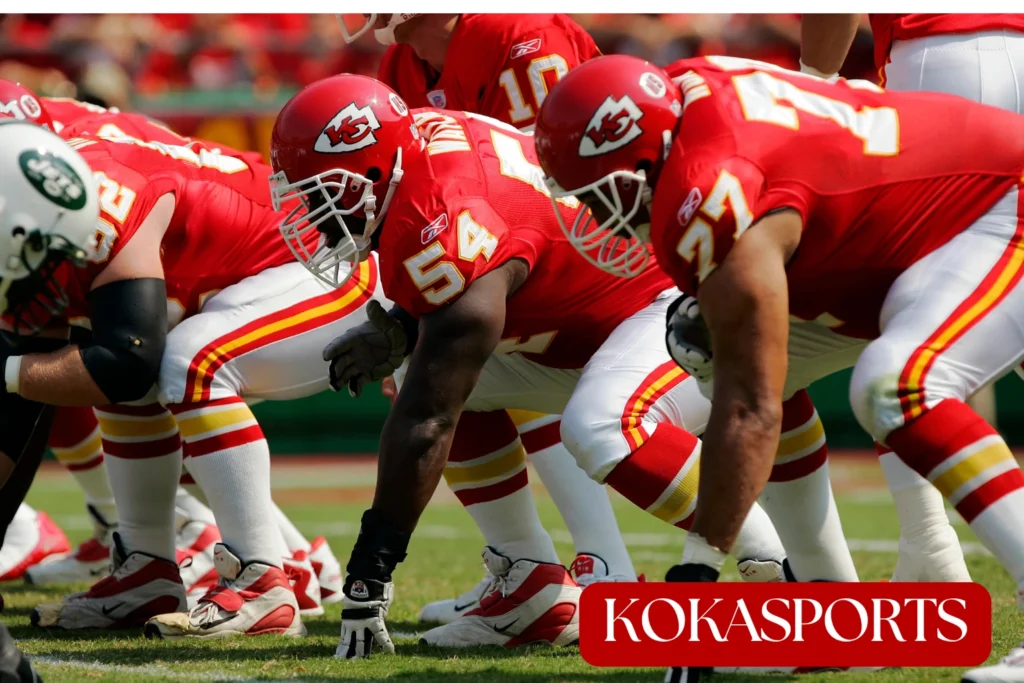
Pass Protection Fundamentals
When the quarterback drops back from the line to throw a pass, the offensive line must create a “pocket” of protection. This means all five offensive players work together to keep defensive lineman away from the quarterback. The pocket gives the quarterback time to find wide receiver players who are running pass routes.
Pass protection requires several key elements:
- Good stance and quick first step off the line of scrimmage
- Strong hands to punch and control any defensive player
- Good footwork to stay balanced against pass rushers
- Clear communication with teammates about blocking assignments
- Knowing of the quarterback‘s timing and route concepts
Each offensive lineman must know his assignment perfectly. Sometimes they use “slide protection” where the whole line moves together in one direction. Other times they use “man protection” where each blocker has a specific defensive player to block throughout the pass play.
The offensive line must also watch for blitzes from the opposing team. This is when extra defensive player like linebacker or defensive back players rush the quarterback. When this happens, the running back or tight end might help with additional blocking duties to protect the quarterback.
Run Blocking Schemes
Creating holes for the running back requires different blocking techniques than pass protection. On run plays, the offensive line must move forward and create space for the runner. There are two main types of run blocking schemes that teams use in modern football.
Zone blocking is when each offensive lineman is responsible for an area instead of a specific defensive player. The blockers work together to create running lanes anywhere along the line of scrimmage. If there is no defender in their area, they move to help a teammate. This scheme requires excellent teamwork and communication.
Gap/Power blocking is when each blocker has a specific defensive player to block. This scheme often uses pulling guards who run to other parts of the line to create extra blocking power. Power blocking is especially good for short-yardage situations where the offensive team needs just a few yards for a first down.
Physical and Mental Requirements
Size and Strength Standards
Offensive linemen are typically the biggest people on the football field. In the NFL, these players usually weigh between 300-350 pounds and stand 6’4″ to 6’8″ tall. But size alone is not enough – they must also be very strong and surprisingly athletic for their size.
Physical requirements include specific benchmarks:
- Bench press: 400+ pounds for college level, 500+ pounds for NFL
- Squat: 500+ pounds for college level, 600+ pounds for NFL
- 40-yard dash: Under 5.5 seconds for tackle positions, under 5.8 for guards/center
- Hand size: 9+ inches for better grip and blocking leverage
- Arm length: 32+ inches for tackle positions to keep rushers away
These positions in american football require players who can combine massive size with real athletic ability. Modern offensive lineman players are much more athletic than in the past. They must be able to move sideways quickly and even run downfield to block on some special plays.
Mental Skills and Football Intelligence
Being smart is just as important as being big and strong for offensive line players. These offensive positions require players who can learn complex blocking schemes and make quick decisions during live plays under pressure.
Mental requirements include several key areas:
- Learning multiple blocking schemes and offensive formation concepts
- Reading defensive alignments and making protection calls
- Communicating clearly with teammates during loud crowd noise
- Making split-second decisions about who to block
- Knowing down and distance game situations
The center position requires the most mental skills because this player on the team must make many of the blocking calls for the whole group. But all offensive line players must be smart enough to handle their complex responsibilities in this football league.
All Time Best Offensive Linemen In American Football
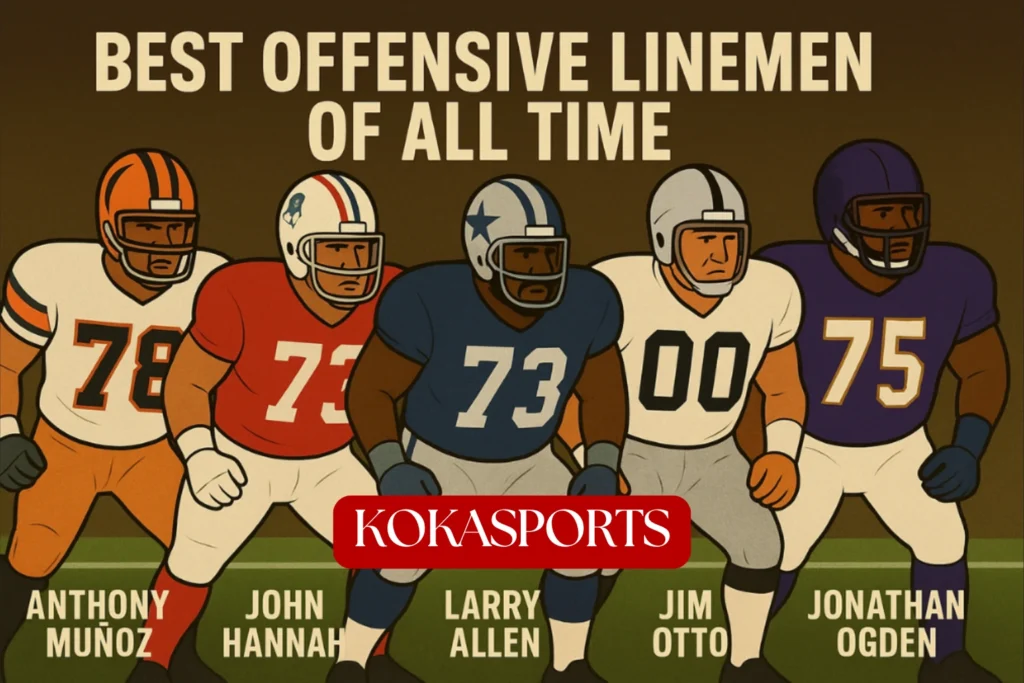
Anthony Muñoz (OT, Cincinnati Bengals) – Widely considered the greatest offensive tackle ever, dominating in both pass protection and run blocking.
John Hannah (G, New England Patriots) – Legendary guard, often called the best interior lineman in NFL history.
Larry Allen (G/T, Dallas Cowboys) – Known for his rare combination of size, strength, and agility, a dominant force on the Cowboys’ line.
Jim Otto (C, Oakland Raiders) – Iconic center with unmatched toughness, anchoring the Raiders’ line for 15 seasons.
Jonathan Ogden (OT, Baltimore Ravens) – The first-ever draft pick for the Ravens, an elite left tackle with incredible athleticism.
Professional Development and Special positions
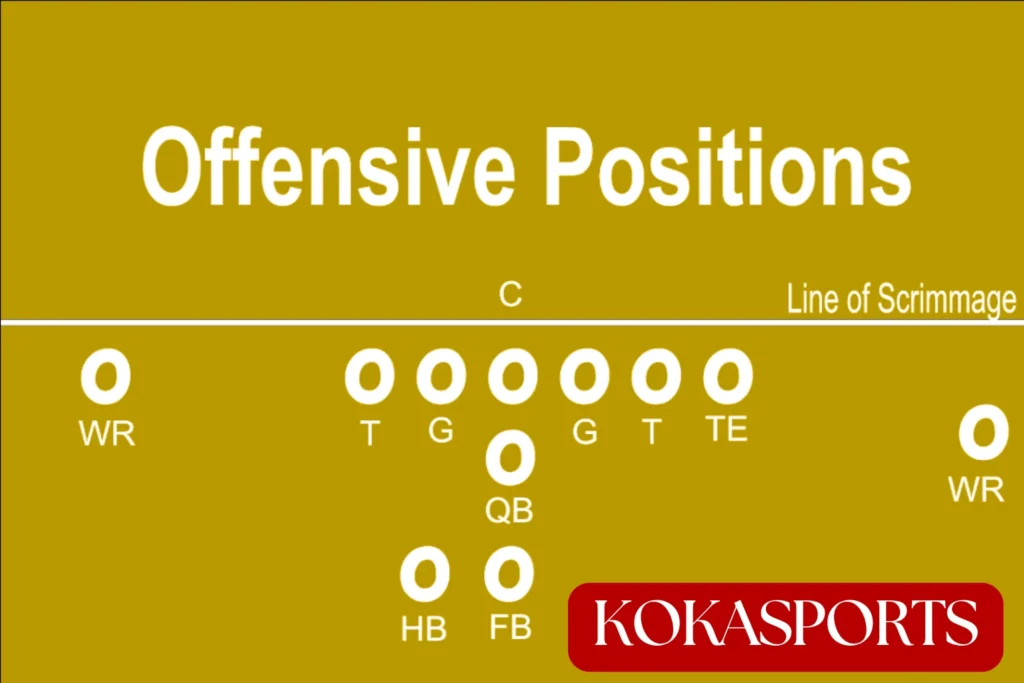
College to NFL Transition
Moving from college football to the NFL is very difficult for offensive line players. The speed and strength of defensive lineman in professional football is much higher than college level. Young players often need 2-3 years to develop into quality starters.
NFL teams specifically look for:
- Players with the right body type and athletic ability
- Good technique and fundamentals from quality college coaching
- Mental toughness to handle very physical play
- Leadership qualities, especially for center and tackle positions
- Ability to play multiple offensive line positions when needed
Special Teams Positions
Many offensive line players also contribute on special teams units throughout games. Their size and blocking skills make them valuable on field goal and extra point attempts. Some offensive lineman players become long snappers, which is one of the special teams positions that requires very accurate snapping on punts and field goal attempts.
Special teams roles for offensive line players include several important jobs:
- Field goal and extra point protection units
- Punt coverage teams where they run downfield
- Kickoff coverage units for field position
- Special teams positions that require specialized blocking skills
- Emergency special teams roles when regular players are injured
The tight end also plays important roles on special teams. These players can catch the ball on fake punts, block on field goal attempts, and cover kicks. Some tight end players are among the best special teams contributors because they combine size with athletic ability.
Advanced Concepts and Modern Evolution
Working Against Different Defensive Alignments
Modern defensive line units use many different alignments to confuse offensive line players. Sometimes the defense shows four defensive linemen across from the offensive line. Other times they might show just three down linemen with extra linebacker players.
The offensive line must be ready to handle various defensive looks:
- Nose tackle alignments where one big player lines up over the center
- Four defensive linemen spread across the line of scrimmage
- Linebacker blitzes from different angles and timing
- Defensive back pressure from the secondary line of defense
- Strong safeties and free safeties coming on delayed blitzes
Each of these defensive looks requires different blocking techniques and communication. The middle linebacker often tries to disguise his intentions, so the offensive line must be prepared for various scenarios. When free safeties or strong safeties blitz, the offensive line must work with wide receiver players and tight end to block defensive players effectively.
Modern Offensive Concepts
Today’s football features more passing than ever before. This means offensive line players must be better at pass protection than in the past. The quarterback often throws the ball quickly to wide receiver players running short routes. This requires the offensive line to give the quarterback just enough time to make accurate throws.
Modern offensive concepts include:
- Quick passing games where the quarterback throws in 2-3 seconds
- Run plays that use offensive line mobility and athleticism
- Pass play concepts that get the ball to wide receiver players quickly
- Integration of tight end players as both blockers and receivers
- Special teams packages that use offensive line players in different roles
The last line of defense for most teams includes defensive back players who are much faster than offensive line players. But modern schemes help offensive line players succeed by using quick timing and smart play design.
Conclusion
The offensive line is the foundation of every successful football team. These five offensive linemen – center, two guards, and two tackle positions – work together to protect the quarterback and create opportunities for the running back.
Understanding these positions explained helps fans appreciate football’s complexity. While these players don’t catch passes like wide receiver players, they make every play possible. From youth football to the NFL, teams with strong offensive lineman players have more success.
The offensive line proves football is the ultimate team sport. When working together with proper technique, they can dominate any defensive line. Whether creating holes for run plays or protecting the quarterback during pass play situations, their work at the line of scrimmage makes all offensive and defensive battles possible on every down.
FAQs
What are the positions on the offensive line in football?
The offensive line includes the left tackle, left guard, center, right guard, and right tackle.
What is the most important offensive line position?
The left tackle is considered the most important because it protects the quarterback’s blind side.
How many offensive positions are there in football?
There are 11 offensive positions on the field.
What is the difference between an offensive lineman and a defensive lineman?
Offensive linemen block to protect the quarterback and create running lanes, while defensive linemen try to stop plays and pressure the quarterback.
What are all the offensive line positions in football?
The five offensive line positions are left tackle, left guard, center, right guard, and right tackle.

